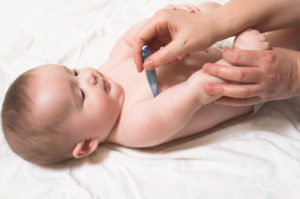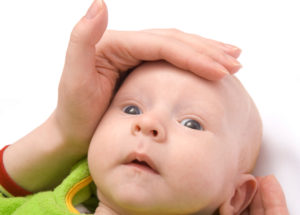Some babies spit up small amounts of milk after or in between feedings. If your baby is healthy, gaining weight and doesn’t seem hungry, spitting up is normal for most babies.
Tips to decrease spitting up:
- Burp your baby during and after a feed
- Hold your baby in an upright position for 20-30 minutes after a feeding
Throwing up (vomiting)
A baby who suddenly starts to vomit large amounts of milk may be ill.
Babies, especially younger than 6 months, need special attention when they are sick and vomit because they can easily become dehydrated. Contact your healthcare provider or the Health Link at 811 if your baby is vomiting and is showing any of the following signs of dehydration:
- dry skin, mouth or tongue
- no spit or tears
- sunken-looking eyes
- urinating less often
- dark coloured urine
- weak or sleepy
- sunken fontanelle (soft spot) in a young baby
Fever
Fever means that your child’s body is reacting to something such as an illness. The most common illness in children is infection from a virus. There are thousands of different viruses. Fever can also result from an infection with bacteria. Fever itself will not harm your child. In fact, fever is one way your child’s body fights an infection.
Taking your baby’s temperature with a thermometer is the best way to tell if your baby has a fever. A normal temperature under the arm is 36.5° to 37.5°C (97.8° to 99.5°F).
Take your baby’s temperature with a thermometer if your baby:
- feels hot to the touch or is flushed
- is fussier than usual
- is feeding poorly
- is sleeping for shorter or longer periods than usual
- appears sick
Using a thermometer:
- Before taking a temperature, unwrap your baby for 5 to 10 minutes. Wait at least 15 minutes after your baby’s bath before taking their temperature.
- Take your baby’s temperature under the arm using an oral or digital thermometer. You can use either kind to take your baby’s temperature under the arm. It is not recommended you take your baby’s temperature rectally as there is a risk of injury. Ear (tympanic) thermometers may not give an accurate reading for children under the age of two.
- Write down the temperature and the time you took it.

If your baby has a fever
- dress your baby lightly in a diaper and undershirt. Losing heat through the skin allows the body cool down and feel more comfortable. If your child starts to shiver, add warmer clothing, but remove it when the shivering stops.
- take off extra clothes and blankets
- give your baby extra breastmilk or formula
It is unknown if bathing in cool water helps to bring down a child’s fever. Your child may feel more comfortable with a lukewarm bath or wet face cloths. A bath that is cool will be uncomfortable. It can also cause a child to shiver which can make the temperature go even higher. Cool baths, alcohol baths and alcohol rubs are not advised. A child’s skin can absorb alcohol and this can be harmful.
Babies younger than 6 months with a fever need to be seen by a healthcare provider because they can become sick very quickly. Babies over 6 months with a fever need to be seen by a healthcare provider if the fever lasts more than 72 hours, occurs with other symptoms (for example rash, vomiting) or if you are concerned.
Colds
Children often get colds. They are likely to have many colds when they are younger and fewer as they get older. Children who are breast/chestfed may have fewer colds. If your baby has a cold, continue to feed you baby based on their feeding cues. Dress them in comfortable clothing and allow them to get plenty of rest. Wash the families hands often.
Call your healthcare provider if your baby has a cold or respiratory illness and:
- doesn’t get better in a few days or seems to be coughing all the time
- is unable to sleep
- has to work hard to breathe or catch her breath
- has a fever and is under 6 months old
- sounds noisy, wheezy or different from normal when they breathe
- has a fever and is under 6 months old
- holds their neck stiffly or has problems turning their head

Respiratory Syncytial Virus (RSV)
RSV is a common cause of colds in winter and early spring. Most children have had the virus by the age of two, but usually only have a mild cold. RSV is very contagious and can live for hours on surfaces such as toys and hands.
Children under one year of age, premature babies and those with lung or heart disease, may develop more serious symptoms from RSV.
The symptoms of RSV may at first be similar to a cold and can include:
- fever
- red eyes, sore ears
- runny/stuffy nose
- other cold symptoms
The symptoms may then get worse and can include:
- difficulty breathing
- rapid breathing
- wheezing
- coughing for up to three weeks
NOTE: Symptoms can change very quickly in infants and young children.
Steps to follow to reduce the risk of RSV infection:
- Wash hands with soap and water before touching the baby
- Keep other children with a cold or fever away from the baby
- Keep the baby away from crowded places
- Do not smoke around the baby
- Wash your baby’s toys often
Although there is no vaccine, parents of children who are at high risk for developing serious RSV infection (for example, premature babies) can speak to their doctor to find out more ways to protect their child against the virus.